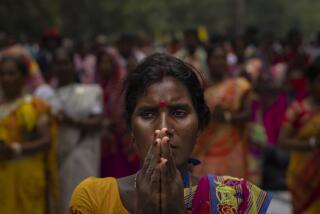Opening Doors for Women
- Share via
PUNE, India — Something unusual is happening behind nondescript gray walls in western India. From within, you can hear the calm, rhythmic sounds of Sanskrit verse. But the chanters here are women--ones who want to be Hindu priests, a role they have been largely denied for 12 centuries.
“The first step has been taken here. We have opened the doors for a revolution,” said head priestess Pushpalata Dharmadhikari.
The 22-year-old Udyan Mangal Karyalaya, or “garden of good” in the Maharashtri language, is the only formal school for female priests in India.
It is one of the few Hindu seminaries of any kind, as most priests of the ancient religion learn the rituals from their fathers and pass them to their sons.
“We have always been criticized. People say women should not learn holy books like the Vedas and cannot teach the scriptures. We let them talk and continue learning,” said Pushpa Thatte, one of the school’s senior priestesses.
Thatte’s late husband Shankarrao, a Hindu scholar, opened the school in 1975 because he believed women should be able to study the Vedas, the Sanskrit philosophical texts that are Hinduism’s scriptures. Only later did he begin to train women as priests at the school in Pune, 100 miles southeast of Bombay.
“He placed an advertisement in a newspaper and this caused quite a stir. More than 150 women replied and only eight women passed the recitation test,” recalled Thatte.
Some 200 students--from homemakers and school teachers to bank employees--are enrolled today. News of the priestesses has traveled widely--and Thatte says people are beginning to prefer having women preside over religious ceremonies.
The women enrolled at Udyan Mangal Karyalaya must study for 10 years or more before being considered full-fledged priests. But even as students, they and the 10 head priestesses are flooded with invitations to conduct marriages, christenings and religious ceremonies in India and abroad.
After 22 performed religious ceremonies in Indian homes in England, they were asked to pray for the settlement of a land dispute of a British friend of an Indian family.
“When the priestesses returned to India, he called back excitedly to ask us to come back for thanksgiving prayers because he had won the case,” Thatte said.
Vikash Gite plans to ask the priestesses to conduct his daughter’s marriage next month.
“I have seen them patiently explain the meaning of the scriptures at another wedding. Male priests tend to go fast-forward through the ceremony and some don’t even know the meaning of what they recite,” he said.
“We explain the meaning of holy words to people and we are in no hurry,” said Vasanthi Khadilkar, a teacher at the school.
Student Alka Bhide offered another reason why the school’s priests are popular.
“We do not insist on a fixed rate unlike the men, but decide according to the financial background of people,” she said. A ceremony organized by the school’s priestesses could cost up to $28; male priests have been known to charge much more.
In the early days of Hinduism, women studied and preached the scriptures. V.L. Manjul, a research scholar who recently published a paper on female priests in the state of Maharashtra, said evidence of female priests and philosophers existed in Hindu scriptures dating back to the 4th century BC.
A more conservative era began in the 8th century, when the Adi Shankaracharya, a Hindu religious leader, interpreted a word in the scriptures denoting a female scholar as “an expert in household work.”
“The status of women fell, and when that happened all privileges were taken away. Women were given a respectful place at home, but not allowed to carry on any intellectual activity,” said Narayan Dutt, a Bombay-based religious scholar with the educational institute Bharatiya Vidya Bhavan.
Student Rohini Ogale says she began studying at Udyan Mangal Karyalaya because she wanted to learn more about Hindu scriptures.
“It increases your mental satisfaction to understand them and explain them to the people around you,” she said.
More to Read
Sign up for Essential California
The most important California stories and recommendations in your inbox every morning.
You may occasionally receive promotional content from the Los Angeles Times.










